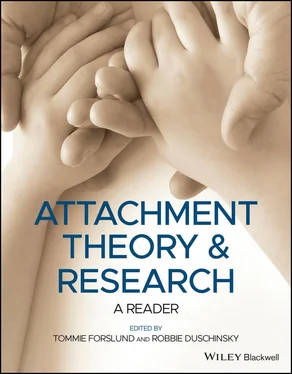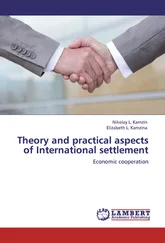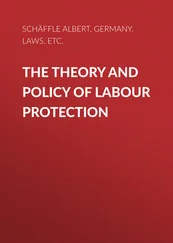1 ...6 7 8 10 11 12 ...30 The initial phase, that of Protest , may last from a few hours to a week or more. During it the young child appears acutely distressed at having lost his mother and seeks to recapture her by the full exercise of his limited resources. He will often cry loudly, shake his cot, throw himself about, and look eagerly towards any sight or sound which might prove to be his missing mother. All his behaviour suggests strong expectation that she will return. Meantime he is apt to reject all alternative figures who offer to do things for him, though some children will cling desperately to a nurse.
During the phase of Despair , which succeeds protest, his preoccupation with his missing mother is still evident, though his behaviour suggests increasing hopelessness. The active physical movements diminish or come to an end, and he may cry monotonously or intermittently. He is withdrawn and inactive, makes no demands on the environment, and appears to be in a state of deep mourning. This is a quiet stage, and sometimes, clearly erroneously, is presumed to indicate a diminution of distress.
Because the child shows more interest in his surroundings, the phase of Detachment which sooner or later succeeds protest and despair is often welcomed as a sign of recovery. He no longer rejects the nurses, accepts their care and the food and toys they bring, and may even smile and be sociable. This seems satisfactory. When his mother visits, however, it can be seen that all is not well, for there is a striking absence of the behaviour characteristic of the strong attachment normal at this age. So far from greeting his mother he may seem hardly to know her; so far from clinging to her he may remain remote and apathetic; instead of tears there is a listless turning away. He seems to have lost all interest in her.
Should his stay in hospital or residential nursery be prolonged and should he, as is usual, have the experience of becoming transiently attached to a series of nurses each of whom leaves and so repeats for him the experience of the original loss of his mother, he will in time act as if neither mothering nor contact with humans had much significance for him. After a series of upsets at losing several mother‐figures to whom in turn he has given some trust and affection, he will gradually commit himself less and less to succeeding figures and in time will stop altogether taking the risk of attaching himself to anyone. Instead he will become increasingly self‐centred and, instead of directing his desires and feelings towards people, become preoccupied with material things such as sweets, toys, and food. A child living in an institution or hospital who has reached this state will no longer be upset when nurses change or leave. He will cease to show feelings when his parents come and go on visiting day; and it may cause them pain when they realize that, although he has an avid interest in the presents they bring, he has little interest in them as special people. He will appear cheerful and adapted to his unusual situation and apparently easy and unafraid of anyone. But this sociability is superficial: he appears no longer to care for anyone.
We have had some difficulty in finding the best term to denote this phase. In previous papers and in the early drafts of this one the term ‘denial’ was used. It gave rise to many difficulties, however, and is now abandoned in favour of the more purely descriptive term ‘detachment’. An alternative is ‘withdrawal’, but this has two disadvantages for my purpose. In the first place there is a danger that it might convey the picture of an inactive child withdrawn from the world, a picture that is the opposite of what often obtains. In the second, in psycho‐analytic writing it is commonly associated with libido theory and the idea of instinct as a quantity of energy which can be withdrawn, a model I am not using. Not only does the term ‘detachment’ have neither of these disadvantages, but it is a natural counterpart of ‘attachment’. The nature of the defence process, or processes, that give rise to it is of course a matter for detailed study. In an earlier publication (Bowlby, 1954) I have discussed briefly its relation to repression and I hope at a later date to give this further attention.
Returning now to the empirical data, I wish to emphasize that the behaviour seen in the phases of Protest and Despair is not, as is sometimes alleged, confined to children whose relations to their mothers are already impaired. Though we have no large series of well‐observed cases to quote, we are satisfied that there is clear evidence that it occurs in children whose previous relationships would be judged to have been anything between excellent and fairly unfavourable. It appears to be only in children whose relationships are already severely impaired, and who may therefore already be in a phase of Detachment, that such behaviour is absent.
In examining the theoretical problems raised by these observations it is convenient to consider them with reference to these three phases of behaviour. The phase of Protest raises the problem especially of separation anxiety; Despair that of grief and mourning; Detachment that of defence. Each of them is central to psychoanalytic theory and will therefore need detailed discussion – the first in this paper, the second and third in succeeding ones. The thesis to be advanced is that the three types of response – separation anxiety, grief and mourning, and defence – are phases of a single process and that when treated as such each illumines the other two.
Often in the literature they have been considered piecemeal. The reason for this appears to be the inverted order in which their psycho‐pathological significance was discovered: for it was the last phase which was recognized first, and the first last. Thus the significance of defence, particularly repression, was realized fully by Freud in the earliest days of his psycho‐analytic work and provides the basis of his classical theorizing: his first paper on the subject is dated 1894 (Freud 1894). His grasp of the roles of grief and separation anxiety on the other hand, although not wholly absent in his earlier work, was none the less fragmentary. Thus, although early alive to the place of mourning in hysteria and melancholia (Freud, [1897] 1954), twenty years were to elapse before, in Mourning and Melancholia (1917), he gave it systematic attention. Similarly in the case of separation anxiety: although in the Three Essays on Sexuality (1905) he gave it a paragraph (p. 224), and in the Introductory Lectures (1917) three pages (pp. 339–341), it is not until 1926 that in his important late work, Inhibitions, Symptoms and Anxiety (Freud, 1926), he gives it the central place in what was to be his final theory of anxiety. ‘Missing someone who is loved and longed for’ he affirms, ‘is the key to an understanding of anxiety’ (pp. 136–137), and it is on this datum that the whole argument of his book rests.
The reason for this inverse recognition of the three phases is clear: always in the history of medicine it is the end result of a pathological sequence which is first to be noted. Only gradually are the earlier phases identified, and it may be many years before the exact sequence of the whole process is understood. Indeed it was understanding the sequence which baffled Freud longest. Does defence precede anxiety, or anxiety defence? If the response to separation is pain and mourning, how can it also be anxiety? (Freud, 1926, pp. 108–109 and 130–131). It can now be seen that during the thirty years of his main psycho‐analytic explorations Freud traversed the sequence backwards, from end result to initial stage. Not until his seventieth year did he clearly perceive the source and course of the processes to which he had devoted half a lifetime of study. The effects on psychoanalytical theorizing have inevitably been confusing.
Читать дальше












